Navigation
Tayna Gorilla Reserve Brings Communities and Orphans Together to Save Wildlife
The 225,000-acre Tayna Gorilla Reserve not only protects gorillas, elephants, and leopards, but also provides many locals with jobs. Last year, Pierre Kakule Vwirasihikya helped start a community college called Tayna Center for Conservation Biology, where more than a hundred Congolese students are studying natural resource management and conservation.
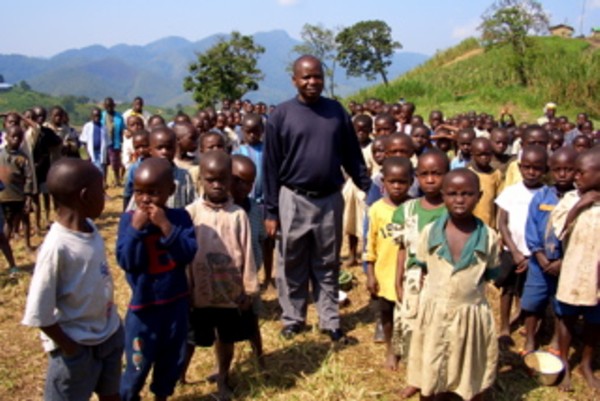 |
| Conservator in Chief Pierre Kakule Vwirasihikya with school children |
Summary:
The 225,000-acre Tayna Gorilla Reserve not only protects gorillas, elephants, and leopards, but also provides many locals with jobs. Last year, Pierre Kakule Vwirasihikya helped start a community college called Tayna Center for Conservation Biology, where more than a hundred Congolese students are studying natural resource management and conservation.
Background:
The Tayna Gorilla Reserve (Réserve des Gorilles de Tayna: R.G.T) is a community-based conservation program created on April 1998 under the initiative of Conservator in Chief Pierre Kakule Vwirasihikya in order to safeguard an important population of the endangered Grauer's gorillas and to provide for the economic well being of future generations of the Batangi and Bamate peoples in this eastern region of the Democratic Republic of Congo.
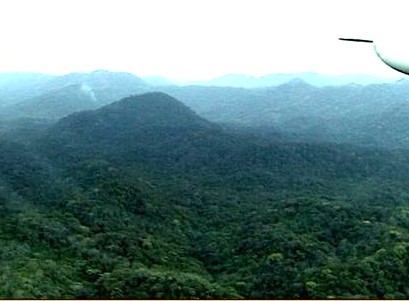 |
| Mountain ranges of the Reserve |
The Tayna Gorilla Reserve is located in a part of North Kivu Province (Lubero Territory) known for its rich biodiversity and for the abundance of other rare animals such as bonobos, okapis, chimpanzees, antelopes, leopards, crocodiles of the Nile, and forest elephants.
Because of the region’s remoteness, its ecosystem has been spared many of the ravages of mining and natural resource exploitation. Its population, however, has not been so fortunate.
The long civil war, which has killed upwards of 3 million people, has orphaned many Batangi and Bamati children. The Tayna Gorilla Reserve provides education and training for many of these orphans as well as for others who seek training in sound conservation scholarship and management practices. Pierre Kakule Vwirasihikya, himself a local chief, organized other area chiefs who in turn developed a supportive consensus among the whole population.
Together, they realized the importance of protecting their natural resources and of stopping the poaching and uncontrolled exploitation that they saw occurring in other territories.
The Tayna Gorilla Reserve is the fruit of this cooperation. It is a protected area, owned and maintained by the local population, and occupies a unique transitional area between the valley of the River Congo and the Albertine Rift. It has not yet been scientifically studied by many researchers, and, Pierre Kakule Vwirasihikya says, “We believe it should be a priority for nature conservation efforts.”
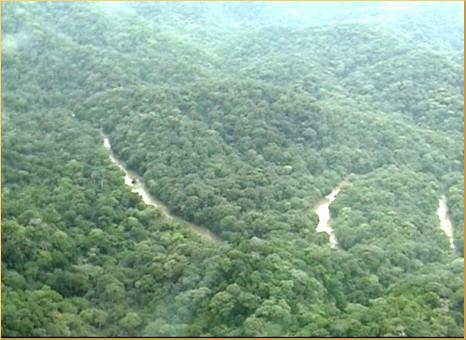 |
| Primary Riverine Forest |
The Tayna Gorilla Reserve of was very quickly accepted in the region. The R.G.T has continued to involve the local population in the collaborative community process that was fundamental to its development.
A “family” of local community conservators was created, including everyone from native farmers to the two traditional chiefs. This collective family is fighting against the destruction of the species and reaching out to local communities in the following ways:
- Creation of dialogue committees among the villagers that work to discourage and eliminate poaching.
- Recruitment of children from the area to serve on the project staff.
- Execution of developmental projects.
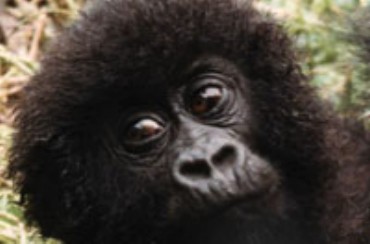 |
| Picture by UNEP see related article: Saving King Kong on the Solutions Site at http://www.solutions-site.org/artman/publish/article_230.shtml |
Scientific Research
In keeping with the basic plan, the R.G.T built four scientific stations where research activities are underway. The R.G.T has made an inventory of the fauna and an inventory of the flora is being done. The R.G.T is also working to accustom gorillas with the area of one of the scientific stations in order to develop eco-tourism, envisioned as a means of self-financing the project.
Sustainable Development Actions:
Actions of the R.G.T. include:
- Opening and the rehabilitating agricultural roads.
- Supporting the medical sector including by providing medical assistance to the local population, constructing and rehabilitating sanitary services, and providing education about sanitation.
- Supporting the education of children.
- Providing assistance to vulnerable people, especially widows and orphans.
- Providing for clean water.
- Installing a community radio.
- Making agricultural decisions within the framework of food security while enabling conservation to succeed.
- Establishing a university for the region.
- Supporting reafforestation.
Education and Founding of Similar Conservation Reserves:
After receiving substantial education and training by R.G.T., residents from other traditional areas including Walikale, Masisi, Mwenga and Punia, followed its leadership and created similar community conservation reserves. Eight associations have been established since December 2nd 2002.
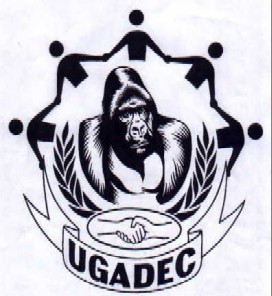 |
| UGADEC poster |
The eight groups came together in a union named the Union of Associations for Conservation of Gorillas and for Development in the East Democratic Republic of the Congo (UGADEC).
They are:
- Ré. Co. Pri.Ba (A Primate Community Reserve of Bakumbule in the Walikale territory),
- ILSN (A local Initiative for Nature Safeguard in Masisi territory)
- RGU (Gorilla Reserve of Usala in Walikale territory)
- REGOUWA (Gorilla Reserve of Utunda and Wasa, in Walikale territory)
- RGPU (Gorilla Reserve of Punia in the Oriental Province)
- ACPN-IM (A Community Action for Nature Protection in Itombwe-Mwenga)
- COCREFOBA (a Community Conservation Association for the Forestry Reserve of Bakano)
The UGADEC objectives include:
- To make familiar the community notion of conservation through each Association located between the Kahuzibiega and Maiko parks and the Itombwe forest.
- To organize training sessions for people to form Community Conservation projects.
- To make people aware of the wildlife in the protected areas by use of mass media.
- To constitute a data bank with inventories of the D.R.C. gorillas of the East as well as other species.
- To assure the continuation of community associations.
- To promote the health and well-being of populations in the protected areas.
- To create an observatory in each conservation association and to become more aware of negative opinions about the conversation efforts and to address those concerns.
- To develop eco-tourism in the Albertine Rift.
In order to assure the future life of these associations and to provide for ongoing managerial skill, the Tayna Centre for Conservation Biology/University of Nature Conservation and for Development at Kasugho (TCCB / UCNDK) was created as a university level center for biological conservation.
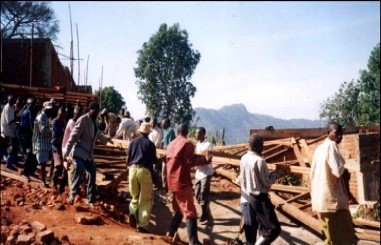 |
| Wildlife Club Members Volunteering |
This educational project for community development works to reinforce the operational and scientific capacities of the UGADEC. Initiated by the Conservator in Chief Pierre Kakule in 2002, after he won the American Society for Primatologists Award, it was formalized on January 5th 2004 during the opening ceremony of the first academic year.
The TCCB began its activities in conformity with the D.R.C. government through the Ministry of Education and Scientific Research, the Ministry of Environment, and the Ministry of Justice.
At the beginning, the Tayna Centre for Conservation Biology had three departments:
- Research and biological conservation.
- Conservation and protected areas development.
- Education, communication, and information.
Starting with the 2004-2005 academic year, the Center is functioning in its own buildings with its head office in Kasugho, Lubero territory, North Kivu in the east of Democratic Republic of the Congo. In addition to a permanent scientific staff, the Center recruits visiting teachers from national and foreign universities. Its offices have 11 computers and one photocopier. It is trying to secure more equipment.
Building construction continues along with such activities as improving the water supply, advancing appropriate agriculture and fish culture, and breeding cows and chickens.
A medical center and community radio are already in place.
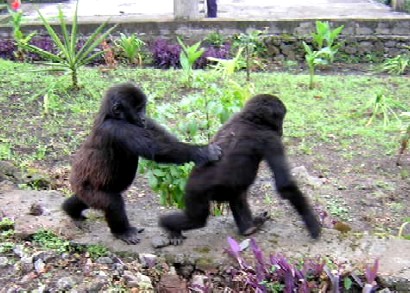 |
| Rescued orphans at play |
A sanctuary that will be a reserve for illegally captured primates is also being prepared.
In addition, the R.G.T. has created several loosely federated clubs called Friends of the Tayna Gorillas (Club of the Friends of Gorillas of Tayna: CAGT) throughout the whole reserve, and their members are educating their communities about the logic of the preservation effort.
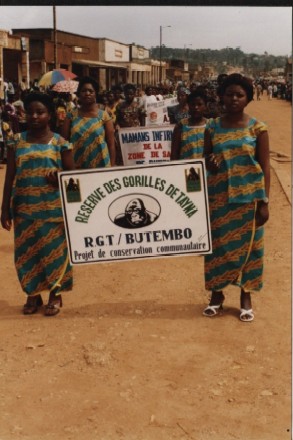 |
| RGT/Butembo Wildlife Club Members |
Conservation actions can only last when a local population understands and supports the objectives. The Tayna Centre for Conservation Biology Wildlife Club is aware of the importance of this and builds on local knowledge to foster an appreciation of the importance of protecting wildlife in the reserves.
The club has approximately 300 young people, many of them orphans, of whom half are women. They use theatre and organize outreach activities to transform public attitudes about poaching and the purchase of “bush meat.”
The TCCB wildlife club volunteers are daughters and sons of those landowners who gave their lands for the creation of reserves as members of the UGADEC. The Club helps focus the attention of young, passionate activists on conservation issues by reinforcing their attachment to the environment and stimulating their interest in the conservation of natural resources.
A primary objective of the club is to develop conservation leaders who will fight poaching in the various reserves and reduce the consumption of meat from wild animals in their own communities. To help achieve that aim, the 300 members of the club have come to the Tayna Centre for Conservation Biology in order to be educated as conservator agents of natural resources. These young agents are being equipped to manage the conservation projects in their home areas. There is a positive morale among them, and they organize matches for their own soccer team, called “Gorilla.”
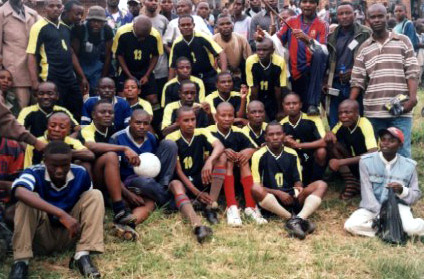 |
| Soccer Team |
These young agents are being equipped to manage the conservation projects in their home areas. There is a positive morale among them, and they organize matches for their own soccer team, called “Gorilla.”
The club is a different initiative from the Union of Associations for Conservation of Gorillas and Community Development in the East of Congo (UGADEC). Only a few members work at the UGADEC and the majority of TCCB Wildlife Club members are orphans or from very poor families (often made destitute by the war’s looting). For this reason, the club needs specific funds to finance not only the education of its members but also its activities. In order to obtain their education and to sustain their basic needs, each young person must try to find money for school fees (about $500 US a year). Many are undernourished. The club has launched an emergency appeal to anyone of good will who will contribute to sustain its efforts to save wildlife and biodiversity in general. The support TCCB Wildlife needs for one year is $108,000 for all the members’ living needs and studies.
Contact:
Pierre Kakule Vwirasihikya
Tayna Gorilla Reserve Coordinator
V. P. Conservation,
International Primatological Society
PO Box 167
Gisenyi, Rwanda (Goma, Democratic Republic of Congo )
Tel: 00(250)08653697
Cell: +243997621861 Democratic Republic of Congo
E-mail : pktayna@yahoo.fr
Case study prepared by Pierre Kakule Vwirasihikya
With the assistance of Elisabeth Higgins Null, Editor
The Reserve receives support from Dian Fossey Gorilla Fund International (DFGF-I) and the Conservation International (CI), among others.
“Any materials you can send would be appreciated and be well used.” Pierre Kakule
The needs for the TCCB include:
- Computers for students,
- Laptops for researchers
- Buses and vans
- Sleeping bags
- Refrigerators to keep medicine
- Medicine (anti – malaria, antibiotics)
- Compasses
- Backpacks
- Walkie-talkies
- TVs
- Waterproof Coats
- Boots
- Field uniforms
- GPS units
- Field watches
- Tents
- Blankets
- Field mattresses
Search
Latest articles
Agriculture
- World Water Week: Healthy ecosystems essential to human health: from coronavirus to malnutrition Online session Wednesday 24 August 17:00-18:20
- World Water Week: Healthy ecosystems essential to human health: from coronavirus to malnutrition Online session Wednesday 24 August 17:00-18:20
Air Pollution
- "Water and Sanitation-Related Diseases and the Changing Environment: Challenges, Interventions, and Preventive Measures" Volume 2 Is Now Available
- Global Innovation Exchange Co-Created by Horizon International, USAID, Bill and Melinda Gates Foundation and Others
Biodiversity
- It is time for international mobilization against climate change
- World Water Week: Healthy ecosystems essential to human health: from coronavirus to malnutrition Online session Wednesday 24 August 17:00-18:20
Desertification
- World Water Week: Healthy ecosystems essential to human health: from coronavirus to malnutrition Online session Wednesday 24 August 17:00-18:20
- UN Food Systems Summit Receives Over 1,200 Ideas to Help Meet Sustainable Development Goals
Endangered Species
- Mangrove Action Project Collaborates to Restore and Preserve Mangrove Ecosystems
- Coral Research in Palau offers a “Glimmer of Hope”
Energy
- Global Innovation Exchange Co-Created by Horizon International, USAID, Bill and Melinda Gates Foundation and Others
- Wildlife Preservation in Southeast Nova Scotia
Exhibits
- Global Innovation Exchange Co-Created by Horizon International, USAID, Bill and Melinda Gates Foundation and Others
- Coral Reefs
Forests
- NASA Satellites Reveal Major Shifts in Global Freshwater Updated June 2020
- Global Innovation Exchange Co-Created by Horizon International, USAID, Bill and Melinda Gates Foundation and Others
Global Climate Change
- It is time for international mobilization against climate change
- It is time for international mobilization against climate change
Global Health
- World Water Week: Healthy ecosystems essential to human health: from coronavirus to malnutrition Online session Wednesday 24 August 17:00-18:20
- More than 400 schoolgirls, family and teachers rescued from Afghanistan by small coalition
Industry
- "Water and Sanitation-Related Diseases and the Changing Environment: Challenges, Interventions, and Preventive Measures" Volume 2 Is Now Available
- Global Innovation Exchange Co-Created by Horizon International, USAID, Bill and Melinda Gates Foundation and Others
Natural Disaster Relief
- STOP ATTACKS ON HEALTH CARE IN UKRAINE
- Global Innovation Exchange Co-Created by Horizon International, USAID, Bill and Melinda Gates Foundation and Others
News and Special Reports
- World Water Week: Healthy ecosystems essential to human health: from coronavirus to malnutrition Online session Wednesday 24 August 17:00-18:20
- STOP ATTACKS ON HEALTH CARE IN UKRAINE
Oceans, Coral Reefs
- World Water Week: Healthy ecosystems essential to human health: from coronavirus to malnutrition Online session Wednesday 24 August 17:00-18:20
- Mangrove Action Project Collaborates to Restore and Preserve Mangrove Ecosystems
Pollution
- Zakaria Ouedraogo of Burkina Faso Produces Film “Nzoue Fiyen: Water Not Drinkable”
- "Water and Sanitation-Related Diseases and the Changing Environment: Challenges, Interventions, and Preventive Measures" Volume 2 Is Now Available
Population
- "Water and Sanitation-Related Diseases and the Changing Environment: Challenges, Interventions, and Preventive Measures" Volume 2 Is Now Available
- "Water and Sanitation-Related Diseases and the Changing Environment: Challenges, Interventions, and Preventive Measures" Volume 2 Is Now Available
Public Health
- Honouring the visionary behind India’s sanitation revolution
- Honouring the visionary behind India’s sanitation revolution
Rivers
- World Water Week: Healthy ecosystems essential to human health: from coronavirus to malnutrition Online session Wednesday 24 August 17:00-18:20
- Mangrove Action Project Collaborates to Restore and Preserve Mangrove Ecosystems
Sanitation
- Honouring the visionary behind India’s sanitation revolution
- Honouring the visionary behind India’s sanitation revolution
Toxic Chemicals
- "Water and Sanitation-Related Diseases and the Changing Environment: Challenges, Interventions, and Preventive Measures" Volume 2 Is Now Available
- Actions to Prevent Polluted Drinking Water in the United States
Transportation
- "Water and Sanitation-Related Diseases and the Changing Environment: Challenges, Interventions, and Preventive Measures" Volume 2 Is Now Available
- Urbanization Provides Opportunities for Transition to a Green Economy, Says New Report
Waste Management
- Honouring the visionary behind India’s sanitation revolution
- Honouring the visionary behind India’s sanitation revolution
Water
- Honouring the visionary behind India’s sanitation revolution
- Honouring the visionary behind India’s sanitation revolution
Water and Sanitation
- Honouring the visionary behind India’s sanitation revolution
- Honouring the visionary behind India’s sanitation revolution

